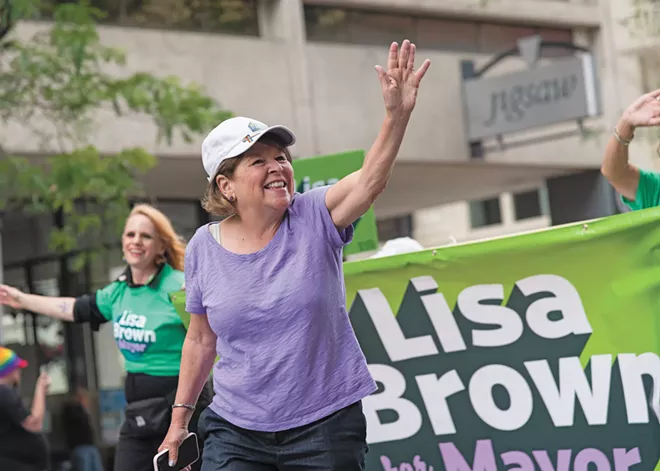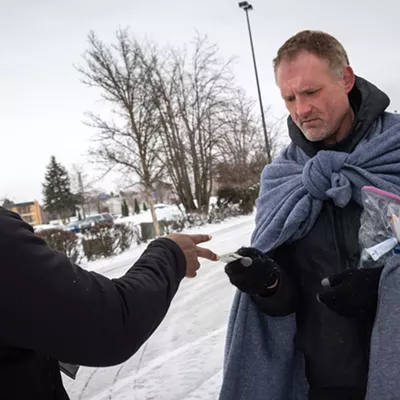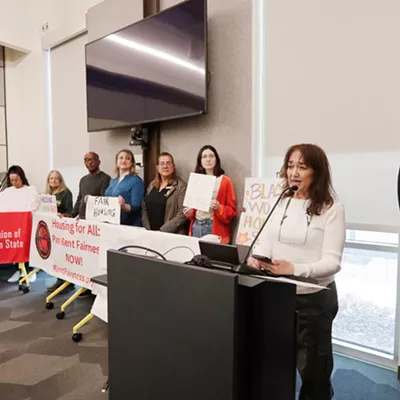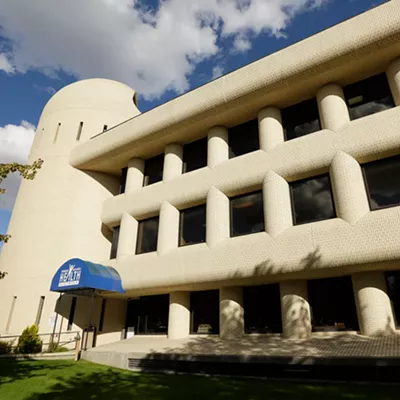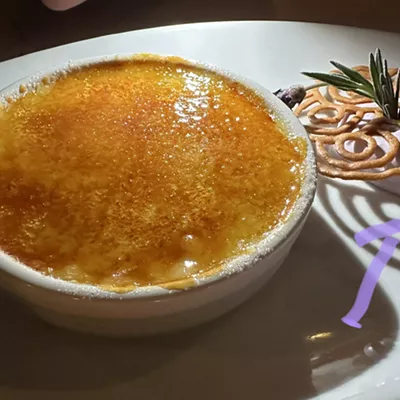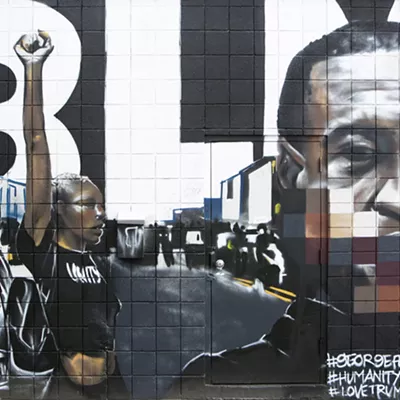If you thought last year was a lot, wait till you get a load of the year ahead.
Aside from a presidential race no one is looking forward to, a potentially competitive challenge to U.S. Rep. Cathy McMorris Rodgers, ongoing wars in various parts of the globe, the increasing devastation wrought by climate change, the increasing gap between the rich and the poor, and the general distrust we Americans have for one another... let's just say there's a lot to prepare for this year.
MORE BALLOTS TO FILL OUT
Tired of elections? Too bad. Washington voters are going to have a lot of bubbles to fill in this year.
The first — Measure 1 — asks voters if they're OK raising property taxes to fund libraries. If approved, the levy would raise $2.5 million annually for three years.
Next up is Measure 2, which would amend the city charter to change the way City Council determines district boundaries with the goal of removing City Council influence and perceptions of partisanship from the process. The ballot measure aims to avoid a repeat of last year's contentious redistricting fiasco.
In August, Spokane voters will once again be asked if they want to raise property taxes. This time, the money would go toward the city's parks department to fund three new parks, playgrounds, park rangers, maintenance and other expenses. The levy would raise $225 million over 20 years.
Spokane voters will also have a chance to choose Washington's next governor in August.
Washington has a "top-two" primary system, which means all candidates in every race will appear on the ballot regardless of party affiliation. The top two will move on to the Nov. 5 general election.
As if the parks, library, redistricting and gubernatorial votes weren't enough to keep track of, 2024 is also a presidential election year. The current guy and the former guy. Or maybe someone else. Who knows! Anything could happen. (NS)
SCHOOLS ON THE BALLOT
There's more! In February, schools across the Inland Northwest will be placing operational levies and bond measures on the ballot. These decisions come to voters every few years as local public schools hope to maintain funding for specific programs and look to address school infrastructure — in some cases that means building new schools, and in others it means modernizing current schools that may not be in the best shape. Below are a few to expect.
The Spokane Public Schools Board of Directors approved a $200 million bond measure and a $300 million three-year replacement levy to be sent to voters. The levy will maintain student programs that don't get enough funding from state and federal funds like sports, clubs and intramural programs, according to SPS. The bonds will fund modernization efforts at some middle and high schools and the replacement of two elementary schools.
Unlike levies, which require a simple majority, bonds require 60% voter approval to pass.
Voters in the Central Valley School District can expect two separate levies on their ballots. One is a $137 million three-year educational programs and operations levy, and the other is a $47.5 million six-year capital safety, facilities and technology improvements levy.
The larger levy is around $45 million more than voters approved in 2021, so its fate is unclear. While the school board voted unanimously to put it on the ballot, some school board members worried it would be unappealing to voters experiencing economic strain.
The capital levy is similarly unclear as it has never been placed on the district's ballots before. With these funds, the district plans to complete necessary updates in aging schools and introduce more security measures like cameras and alarms.
The Mead School District will be asking its voters to approve a $91 million three-year replacement levy. Like the other districts, this will help the district maintain funding for some of its programs. According to MSD data, this levy will amount to approximately 14% of the district's annual operating budget. (CR)
LET'S SAY GAY
Newly released data from UCLA's Williams Institute identified Washington as one of the gayest states in the nation — nearly 400,000 LGBTQ+ residents make up about 7% of the state's entire population. This data, however, only looks at population totals and fails to dig any deeper.
Luckily, the Washington State LGBTQ Commission is on it.
Earlier this year, the commission approved a $500,000 award to a team led by Washington State University researcher Traci Gillig, so they could conduct a survey of the state's LGBTQ+ community. This will be the first survey of its kind in the state and once it's complete, Gillig plans to use the data to inform further research on the experiences of LGBTQ+ folks across the state, the WSU Insider reports.
Specific survey questions haven't been nailed down yet, but researchers hope to collect data on health and safety concerns, geographical distribution and economic opportunities. Data collection is set to begin in 2024 with researchers planning to deliver results in 2025. Look forward to Inlander coverage this year on the survey and its potential impact throughout Washington. (CR)
DAMS WON'T BE BREACHED
Late last year, the Biden administration announced major new agreements with Pacific Northwest tribes meant to restore salmon runs throughout the Columbia-Snake River Basin.
In September, Biden directed federal agencies to prioritize the restoration of healthy salmon runs in the upper Columbia Basin, where dams installed over the last century have completely blocked salmon passage. The agreement with the Confederated Tribes of the Colville Reservation, the Coeur d'Alene Tribe and the Spokane Tribe of Indians includes $200 million over the next 20 years to continue restoration work.
Lower in the basin, groups have been calling for decades to remove the four lower Snake River dams to ease passage for salmon and other fish.
On Dec. 14, the Biden administration announced another agreement with the Nez Perce Tribe, the Confederated Tribes and Bands of the Yakama Nation, the Confederated Tribes of the Umatilla Indian Reservation, the Confederated Tribes of the Warm Springs Reservation, and the states of Oregon and Washington. Dubbed the "Columbia Basin Restoration Initiative," the agreement (which addresses federal litigation) will invest $300 million in fish restoration over the next 10 years.
Plus, the White House announced that the Department of Energy is committed to support one to three gigawatts of clean energy projects sponsored by tribes, bringing the overall investment up to $1 billion. That clean energy infrastructure could replace the dams' power generation if Congress agrees to breach the lower Snake River dams.
The four dams collectively have the potential to generate about 3,500 megawatts of power, but actually produced up to 2,300 sustained megawatts during peak events like the 2021 heat dome, according to a 2022 study commissioned by the Northwest Power and Conservation Council. There are 1,000 megawatts in a gigawatt.
Still, even with the major investments getting underway, the dams won't be breached this year. If Congress were to agree to remove the dams tomorrow, the multibillion-dollar effort would take several years to complete. Unfortunately, tribal fisheries programs and environmental groups have pointed out that the endangered fish runs don't have much time left before they hit their breaking point. (SW)
NIC CLARITY
The future of North Idaho College has never been more uncertain than it was in 2023. Early in the year, the Northwest Commission on Colleges and Communities issued what was essentially a final warning that stated the college was out of compliance with "eligibility requirements and standards related to its governance." Then in July, the NWCCU extended that warning — called a show cause sanction — and provided the college with a list of concerns that would need to be addressed.
In November, the NWCCU published its first evaluation report with suboptimal results — namely due to the board of trustees. The commission's litany is long: NIC still is paying for two presidents. Neither of NIC's two pending lawsuits had been settled. But, since the report was published, one lawsuit — which saw former Coeur d'Alene City Attorney Mike Gridley challenge the validity of attorney Art Macomber and interim President Greg South's contracts — has been settled and another has taken its place as President Nick Swayne sued the college again, this time for the release of his employment evaluation. Essentially, the college's board has not addressed anything it's been tasked with doing, leaving the NWCCU to conclude little to no progress had been made on its demands of NIC.
This year will likely be even more of a wildcard. The NWCCU has plans for two more visits — one this spring and one in the fall — and with the stagnant state of the first visit report, it's even more unclear what the next one will look like.
Also, the board's three-person far-right majority of Todd Banducci, Mike Waggoner and Greg McKenzie will all be up for election this year. The trio is almost always at odds with trustees Tarie Zimmerman and Brad Corkill, meaning only one trustee would need to be replaced to shift the board's majority. (CR)
PFAS CONTAMINATION
By now, many on the West Plains and throughout the Inland Northwest are at least somewhat familiar with the concerning chemicals in the family of PFAS (per- and polyfluoroalkyl substances). The chemicals have been found contaminating water supplies near Fairchild Air Force Base and Spokane International Airport, largely due to their use in firefighting foam that's used to put out fuel fires. The suite of chemicals, which unfortunately persist in the environment due to their strong chemical bonds, are also used for a host of applications, from making furniture stain resistant to providing protective layers on food packaging to prevent grease leaking through. Because of the wide use of PFAS in everything from nonstick cookware to rain gear, most people have some amount of the chemicals in their blood. That's concerning because some of the chemicals bioaccumulate (remaining in the body over time) and are believed to cause cancer and reproductive health issues.
Washington state has tasked its Department of Ecology with identifying safer alternatives that could be used for some products containing PFAS so the state can start banning the chemicals where possible. A draft report on the topic was released in December, and the first regulations are expected to be finalized by June.
Where safer alternatives for specific products are available, the report suggests restricting the chemicals, such as in all apparel marketed to the public, from athleticwear to menstrual underwear. In other cases, such as with firefighting uniforms, the report suggests requiring manufacturers to simply disclose that the chemicals are being used, because for now there aren't safer alternatives. (SW)
NEW POLLUTION
People have barely gotten past PCBs (the carcinogenic toxins that are polluting the Spokane River) to learn a little about PFAS in recent years. But if you haven't picked up on it yet, the latest chemical that's going to be targeted for pollution reduction is 6PPD-quinone.
What's that, you say? "Can you stop spouting gibberish? The alphabet soup is impossible to understand!"
Well, in a nutshell, this recently discovered bad stuff is formed from tire particles.
As you drive around, your tires start to wear down, and those little pieces that come off interact with the environment, running off the roads via stormwater into our river systems.
The bad news? The Seattle-area researchers who pinpointed the substance in 2020 found that it kills salmon in just hours. To help save fish, automobiles are going to need some new innovations. The Environmental Protection Agency announced in late 2023 that they will soon regulate 6PPD, a chemical that's added to tires to, ironically, prevent them from wearing down, but which also degrades into the toxic substance 6PPD-quinone. (SW)
NEW LEGISLATION
Here are a few pieces of legislation that local elected officials are planning to introduce in 2024.
Council member Zack Zappone says he's planning to introduce an ordinance — tentatively titled "Family-Friendly Beer Gardens" — that will basically make it easier for families to bring their kids with them when they visit outdoor beer gardens.
Newly elected Spokane City Council member Paul Dillon says one of the first ordinances he plans to introduce involves creating a process to remove harmful and racist statues on public property — specifically the downtown statue of 19th-century Navy officer John R. Monaghan in downtown Spokane, which has long been criticized by activists for its racist depictions of Samoan people.
The City Council passed an ordinance to create a process to review the statue this summer, but former Mayor Nadine Woodward vetoed it. Now that Mayor Lisa Brown is in office, Dillon thinks it's time to try again.
Council member Michael Cathcart says he's planning to focus on reforms to processes at City Hall in 2024 — specifically when it comes to budgeting. He says he's especially interested in looking at the idea of transitioning Spokane city government to a biennial budget system. (NS)
FRESH FACES
Spokane City Hall has a lot of vacancies that will need to be filled in 2024.
The biggest and arguably most important position is the District 2 City Council seat that was vacated by Betsy Wilkerson when she was elected City Council president.
Anyone who has lived in District 2 for more than a year is eligible to apply for the interim appointment, which will last until the next City Council election in November 2025.
Applications for the position close on Jan. 5. The six current council members will conduct interviews in mid-January and plan to vote on the winner by Jan. 22.
Brown will also have to choose a new police chief after former Chief Craig Meidl announced his resignation shortly after her election.
Brown says she's still consulting with staff on "best practices on police chief searches and what they have looked like in other cities and timelines." She says she plans to announce the search process soon.
There are a number of other Cabinet-level positions that Brown will have to fill next year. The directors of the city's Neighborhoods Housing and Human Services Department and Community Housing and Human Services Department both resigned this fall. Finding new leadership for the historically high-turnover departments tasked with homelessness will likely be a challenge. (NS)
ONGOING CHALLENGES
Spokane's 350-bed homeless shelter on Trent Avenue — also known as the Trent Resource and Assistance Center, or TRAC — will likely be an ongoing subject of debate and consternation in 2024.
"The issue of resolving where we're headed with TRAC is one thing I'd like to get done early in the year," Brown says.
During the campaign, Brown frequently criticized the warehouse shelter as inefficient and inhumane. She said she wanted to wind it down and replace it with something better.
"I hope that we can come up with an alternative, but like I said, I have to get a team," Brown says. "We have very many vacant positions at high levels at City Hall right now."
A lack of wildfire infrastructure in Spokane's Latah Valley will likely be an ongoing concern too. The city has asked the state to help chip in for a much-needed fire station, but it's unclear if the money will be available during the state Legislature's short session this year. Dillon says he's still interested in exploring a potential development moratorium.
Cathcart notes that the budget the City Council passed this fall fails to address many of the city's long-term financial problems and that sustainable budgeting will also be a key challenge in 2024.
Cathcart says he also hopes to see some of the longstanding communication challenges between the City Council and the mayoral administration addressed this year.
"If we can improve that, have strong communication and no surprises from either side, that would be fantastic," Cathcart says. "If we're not all working together, we're not going to get anything done."
Brown notes that, despite all the challenges, there's still a lot to look forward to in 2024. The new Spokane Velocity soccer team. Gonzaga's new designation as a regional tech hub. And, of course, Expo '74.
"There's going to be some positive, interesting things to work on," Brown says. (NS)
¿QUÉ DICES?
Probablemente no puede entender esta oración. Es importante tener materiales traducidos, especialmente en las oficinas del gobierno. Quizás Spokane County va a cambiar más este año. (SW) ♦



